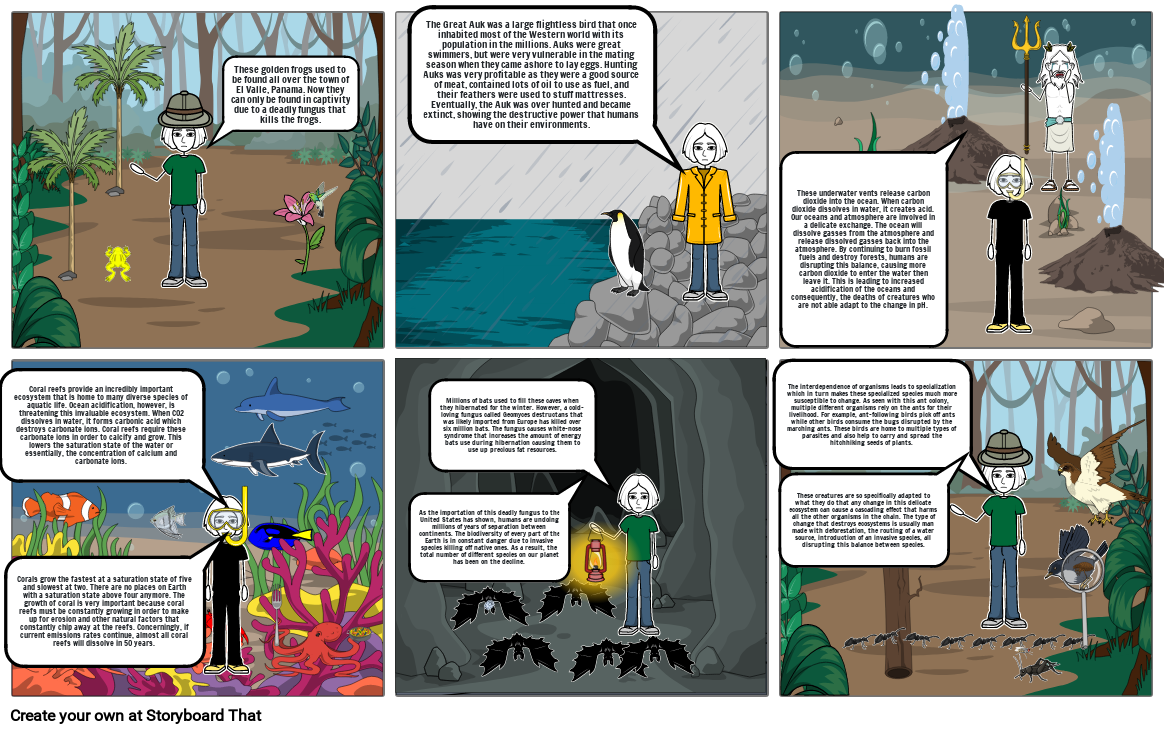The Sixth Extinction Pt. 1

Storyboard Tekst
- These golden frogs used to be found all over the town of El Valle, Panama. Now they can only be found in captivity due to a deadly fungus that kills the frogs.
- The Great Auk was a large flightless bird that once inhabited most of the Western world with its population in the millions. Auks were great swimmers, but were very vulnerable in the mating season when they came ashore to lay eggs. Hunting Auks was very profitable as they were a good source of meat, contained lots of oil to use as fuel, and their feathers were used to stuff mattresses. Eventually, the Auk was over hunted and became extinct, showing the destructive power that humans have on their environments.
- These underwater vents release carbon dioxide into the ocean. When carbon dioxide dissolves in water, it creates acid. Our oceans and atmosphere are involved in a delicate exchange. The ocean will dissolve gasses from the atmosphere and release dissolved gasses back into the atmosphere. By continuing to burn fossil fuels and destroy forests, humans are disrupting this balance, causing more carbon dioxide to enter the water then leave it. This is leading to increased acidification of the oceans and consequently, the deaths of creatures who are not able adapt to the change in pH.
- Coral reefs provide an incredibly important ecosystem that is home to many diverse species of aquatic life. Ocean acidification, however, is threatening this invaluable ecosystem. When CO2 dissolves in water, it forms carbonic acid which destroys carbonate ions. Coral reefs require these carbonate ions in order to calcify and grow. This lowers the saturation state of the water or essentially, the concentration of calcium and carbonate ions.
- Corals grow the fastest at a saturation state of five and slowest at two. There are no places on Earth with a saturation state above four anymore. The growth of coral is very important because coral reefs must be constantly growing in order to make up for erosion and other natural factors that constantly chip away at the reefs. Concerningly, if current emissions rates continue, almost all coral reefs will dissolve in 50 years.
- As the importation of this deadly fungus to the United States has shown, humans are undoing millions of years of separation between continents. The biodiversity of every part of the Earth is in constant danger due to invasive species killing off native ones. As a result, the total number of different species on our planet has been on the decline.
- Millions of bats used to fill these caves when they hibernated for the winter. However, a cold-loving fungus called Geomyces destructans that was likely imported from Europe has killed over six million bats. The fungus causes white-nose syndrome that increases the amount of energy bats use during hibernation causing them to use up precious fat resources.
- The interdependence of organisms leads to specialization which in turn makes these specialized species much more susceptible to change. As seen with this ant colony, multiple different organisms rely on the ants for their livelihood. For example, ant-following birds pick off ants while other birds consume the bugs disrupted by the marching ants. These birds are home to multiple types of parasites and also help to carry and spread the hitchhiking seeds of plants.
- These creatures are so specifically adapted to what they do that any change in this delicate ecosystem can cause a cascading effect that harms all the other organisms in the chain. The type of change that destroys ecosystems is usually man made with deforestation, the routing of a water source, introduction of an invasive species, all disrupting this balance between species.
Meer dan 30 miljoen storyboards gemaakt

